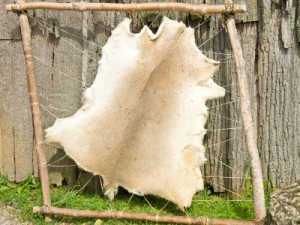

We’ve set up a separate section on the bark tanning techniques of native peoples. However northern indigenous peoples did (and still do) tan furs this way, generally by just applying the tannin to the flesh side and doing it on relatively thin hides. The tannin will stain white and light colored hairs though, so it isn’t as commonly done as some other methods. This is particularly desirable when it is a hide that is so naturally thin and weak that added body strengthens it.

You can find information on the bark tanning of ‘light leathers’ in really old tanning technology books, (but you have to be careful because 95% of what is written about bark tanning is written for tanning dense, heavy leathers).This type of bark tanning tends to involve much less soaking time, weaker tannin solutions, and a softer finished product. Up until the advent of chrome tanning in the late 1870’s, this was commonly done. However, tannins can also be used to create softer, lighter leathers. There is the tanning of ‘heavy leathers’ developed in ancient Egypt, Rome and Greece….which is what we typically think of as “veg tan”, and what you see commercially available. There seem to be two major schools of bark tanning, historically.

You know those beautifully carved holsters and saddles? That’s all done on bark tanned hides. It is used as an integral part of many useful items from bellows, to hinges of trunks, to holding wagon wheels together. It has been commonly used for saddles, canteens, stiff shoes, belts, wallets, holsters, harnesses, helmets, pouches, trunks, shields and gun cases. Commercially it is generally reserved for tanning grain-on leathers from large thick hides such as cattle, horse, buffalo and pig. It can be done to virtually any skin, including weak ones like fish. A huge variety of leathers can be made depending on the skin, the source of the tannin, how much tannin is used and other factors. (the article below was written in 2003, information is outdated, but leaving it up until we get a chance to update)īark tanning (aka vegetable tanning) is an ancient method of creating a durable leather using the tannins from various plants.


 0 kommentar(er)
0 kommentar(er)
